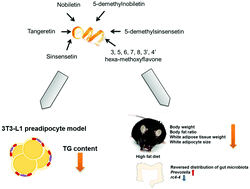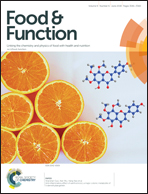Citrus peel extracts attenuated obesity and modulated gut microbiota in mice with high-fat diet-induced obesity†
Abstract
Polymethoxyflavones (PMFs) and hydroxyl PMFs (HOPMFs) are mainly found in citrus peel and have shown anti-obesity potential in in vitro and in vivo studies. Herein, we have investigated the anti-obesity effects of two citrus peel extracts obtained via supercritical fluid extraction: PMF A, with a lower content of PMFs and HOPMFs, and PMF B, with a higher content of PMFs and HOPMFs. PMF A and PMF B were administered orally for 16 weeks to mice with high fat diet (HFD)-induced obesity. The results showed that PMF B decreased the lipid content more statistically significantly (p < 0.05) than PMF A in 3T3-L1 preadipocytes, reduced the adipocyte size, decreased the adipose tissue weight and alleviated the total body weight in the HFD mice. Both PMF A and PMF B reduced the adipocyte size in the perigonadal fat by markedly decreasing the levels of lipid droplets (LD) and perilipin 1 protein and Sterol regulatory element binding protein 1 (SREBP-1) expression. Compared to the case of the HFD group, PMF B altered the gut microbiota by increasing Prevotella and decreasing rc4-4 bacteria. The change in the composition of gut microbiota, the community of symbiotic and pathogenic microorganisms, may determine the metabolic health and be responsible for the anti-obesity mechanism. Our results indicate that the citrus peel extracts decrease lipid accumulation both in vivo and in vitro and should be considered for the management of overweight and obesity conditions.

- This article is part of the themed collection: Around the Supermarket: Staple Foods


 Please wait while we load your content...
Please wait while we load your content...